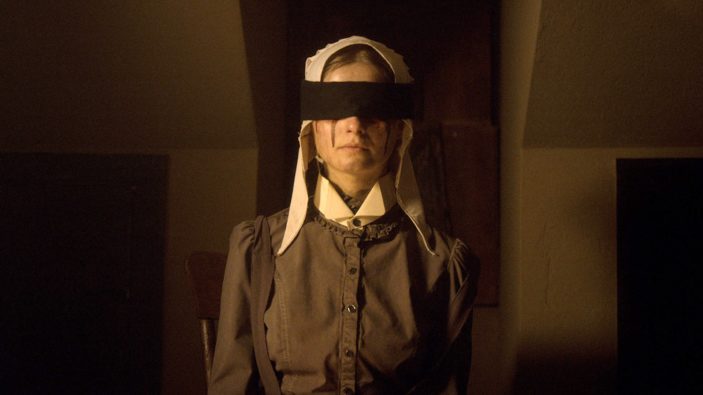
Religious principles and the notion of intolerance run thematically rampant in The Last Thing Mary Saw, a horror-leaning drama film that announces first time filmmaker Edoardo Vitaletti as an intriguing mind to keep our radar on.
Opting for tension and unease rather than overt gore, Mary… is an 1843 set period chiller that opens on the unnerving image of the titular Mary (Stefanie Scott) blindfolded in an interrogation set-up with dried blood pressed against her eyes and cheeks. It’s a startling image and one that through flashbacks will inform us as to how she found herself in such a demeaning, brutal predicament. The relationship between Mary and Eleanor (Isabelle Fuhrman), her family’s agreeable maid, is what ignites a seed of anger throughout Mary’s religious bloodline, and her family – overseen by Judith Roberts‘ stern matriarch – believe that through severe punishment she will be cured of her “sins”.
Despite the 1843 setting, it’s quite rattling that the film’s themes of sexual repression remain relevant in today’s viewing. The idea to keep Mary and Eleanor rather muted throughout seems like a pointed choice in expressing such quelling too, and Vitaletti makes it a point to not linger on any of their romantic embraces either. Mary… runs the risk of souring its stance on the central relationship through its rather brutal treatment of both Mary and Eleanor, but there’s a defiance in their expressions that suggest they’ll retaliate when needed, but as the film also incorporates a supernatural element, this seemingly grounded world never feels safe or guaranteed for anyone involved – innocent or guilty.
Though the relationship between Mary and Eleanor leads to understandable comparisons between itself and the similarly restrictive lesbian love stories of Portrait of a Lady on Fire and Ammonite, Vitaletti is less concerned with the romantic mentality of such a coupling and more the tension created through the outside viewing of Mary’s family. This tension perhaps suggests a graphic nature of fixated violence, but Mary… is alarmingly light on anything gory, preferring instead to highlight a general sense of unease, made all the more potent when Rory Culkin‘s character enters the film – he’s credited only as The Intruder – descending on the house with a menacing nature that Vitaletti gleefully indulges in.
For all its aesthetic pleasures, the story itself may be a bit too slight for viewers, and like the polarising Robert Eggers period horror piece The Witch, those hoping for visual stimulants are likely to be left wanting more as Vitaletti appears to take pride in the subtle and the suggestive. Familiar it may be, Vitaletti’s haunting nature and the utter commitment from the ensemble allow The Last Thing Mary Saw to cast a spell that susceptible viewers are likely to surrender to.
![]()
![]()
![]()
![]()
![]()
THREE AND A HALF STARS (OUT OF FIVE)
The Last Thing Mary Saw is screening as part of this year’s Fantasia Film Festival, which is being presented both virtually and physically between August 5th – 25th, 2021. For more information head to the official Fantasia Film Festival page.
